
SKYPATHS OF THE PLANETS: 2021-2022
Background Sky Maps Credit: Las Cumbres Observatory: Virtual Sky
Because they all circle the Sun in the same direction—counter-clockwise if viewed from above the Solar System— the major planets all move in mostly eastward paths through our sky's background of stars. This is to the left in the images below, as they depict looking up into the sky, rather than down onto a map. Even so, due to our changing "lines of sight" to them as Earth moves in its own orbit, at times the major planets do appear to move "backward" or retrograde from our terrestrial vantage point. This is westward or to the right in the images below.
MERCURY
Retrograde: 2021: Jan 30–Feb 21 May 29–Jun 22 Sep 27–Oct 18
2022: Jan 14–Feb 4 May 10–Jun 3 Sep 10–Oct 2 Dec 29–Dec 31+


Mercury—the closest major planet to the Sun, and likewise the "speediest"—exhibits more instances of retrograde motion than any other planet. In one Earth-year the fleet planet Mercury "goes retrograde" 3 to 4 times against the background of stars, each instance lasting roughly twenty-one Earth-days.
VENUS
Retrograde: 2021 Dec 19–Dec31 2022 Jan1–Jan 29


Venus—the Inner Planet whose orbit is closest in size to Earth's—reverses its generally eastward motion against the background of stars less often than Mercury does. Venus "goes retrograde" about once every one and a half Earth-years, each instance lasting about 41 Earth-days—almost twice the length of each Mercury instance!
The inclination of of the Inner Planets' orbits to the Ecliptic, and the
parallax resulting from their nearness to Earth, make their retrograde loops
and "switchbacks" much more prominent than those of the Outer Planets!
MARS
Retrograde: 2021 (none) 2022 Oct 30–Dec 31+


Mars, the Red Planet, exhibits retrograde motion against the background of stars less often than any major planet. On average Mars "goes retrograde" only once in a little over 2 Earth-years, each instance lasting about 72 Earth-days!
The farther a planet orbits from the Sun, the longer is
the duration of each instance of its retrograde motion!
But the duration can never exceed half of an Earth-year!
As you can see above, Mercury, Venus and Mars—each an Inner Planet—all require scrollable images to depict their motions through 2022. These images are initialized to the far right, as the apparent motion of all the major planets is predominantly eastward (to the left) over time. Even so, in two years' time the Outer Planets (all shown below) appear to move considerably shorter distances through the sky's background of stars. The further an Outer Planet is from the Sun, the shorter its path appears. In two Earth-years Jupiter's path spans only about four hours of Right Ascension, or about 60°, while Saturn's path spans only about half of that! Uranus's path spans only about half again as much, while Neptune's path spans only half an hour of Right Ascennsion, or about 7½°!
JUPITER
Retrograde: 2021: Jun 20–Oct 18 2022: Jul 28–Nov 23
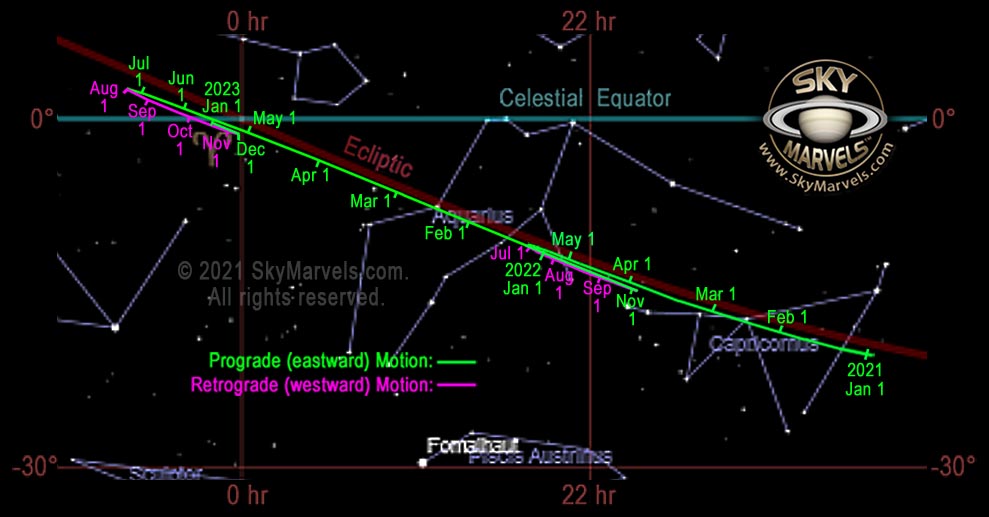
Jupiter "goes retrograde" about once every 399 Earth-days against the background of stars, with each instance lasting about 121 Earth-days!
SATURN
Retrograde: 2021: May 23–Oct 11 2022: Jun 4–Oct 23
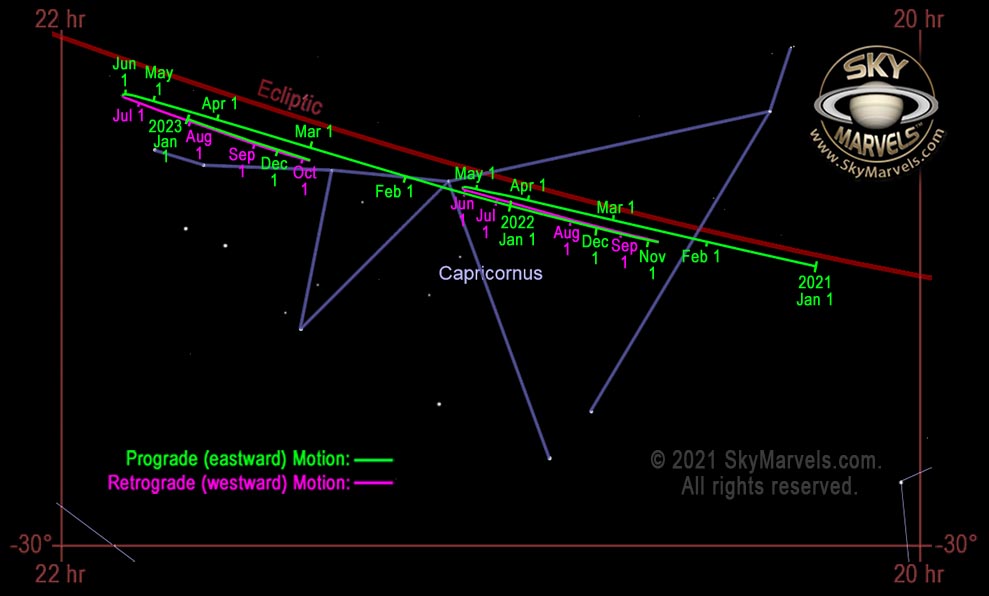
Saturn "goes retrograde" about once every 378 Earth-days against the background of stars, with each instance lasting about 138 Earth-days!
URANUS
Retrograde: 2021: Jan 1–Jan 14 Aug 20–Dec 31+ 2022: Jan 1–Jan 18 Aug 24–Dec 31+
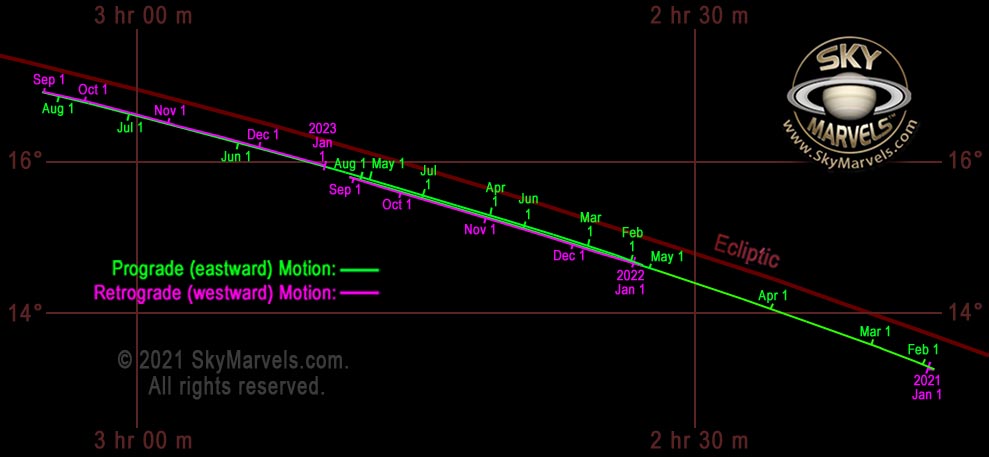
Uranus "goes retrograde" about once every 370 Earth-days against the background of stars, with each instance lasting about 151 Earth-days!
NEPTUNE
Retrograde: 2021: Jun 25–Dec 1 2022: Jun 28–Dec 4

Neptune "goes retrograde" about once every 367 Earth-days against the background of stars, with each instance lasting about 158 Earth-days!
When a planet exhibits retrograde motion depends on two main factors: 1) the size of its own orbit relative to Earth's orbit, i.e. whether it is an Inferior or Superior Planet, and 2) where that planet and Earth are in their orbits.
An Inferior Planet—Mercury or Venus—moves in a retrograde direction
when it is approaching, at, and then receding from "Inferior" Conjunction.
At such times, the planet is "more or less" between Earth and the Sun.
A Superior Planet—Mars, Jupiter, Saturn, Uranus or Neptune—moves in a retro-
grade direction when it is approaching, at, and then receding from Opposition! At
such times, the planet is "more or less" on the opposite side of Earth from the Sun.
The two diagrams below show the Inferior and Superior Planets' various possible orbital configurations ![]()
![]() with Earth, and you can confirm the dates and times that they occur with this Calendar of Astronomical Events. Plus, our views of the current orbital positions of the Inner Planets and Outer Planets can tell you how close a planet may be to achieving a particular configuration with Earth. In addition, this Planetary Configurations Simulator lets you set the heavens in motion for added insights about the skypaths of the planets and their retrograde motions.
with Earth, and you can confirm the dates and times that they occur with this Calendar of Astronomical Events. Plus, our views of the current orbital positions of the Inner Planets and Outer Planets can tell you how close a planet may be to achieving a particular configuration with Earth. In addition, this Planetary Configurations Simulator lets you set the heavens in motion for added insights about the skypaths of the planets and their retrograde motions.
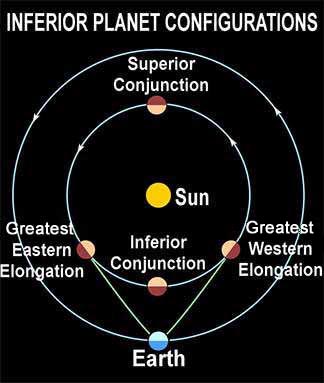
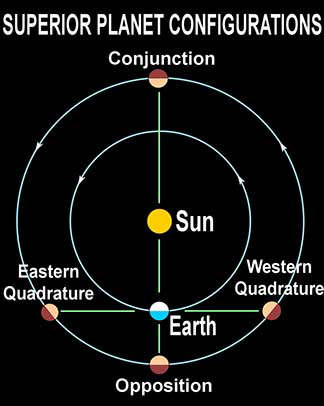
Note: at times it confuses novice astronomy enthusiasts to find the lines joining a constellation's stars drawn differ- ently in different presentations. But the fact is: there is no "official way" to "connect the dots" (so to speak) of the constellations' most prominent stars. As various sources have their own preferences in how they draw them, don't be concerned when you see the asterisms—the popular shapes within constellations—presented in quite an as- sortment of ways. Generally you'll have no trouble recognizing them.
Home Intro News Gallery Sky-Gifts Bonuses Tips
Learning Ctr Help Links Credits Legal Contact Us
© 2007-
by Gary M. Winter. All rights reserved.
Interested in political cartoons and humor?
Check out The HIPPLOMATS™.
SkyMarvels, Sky Marvels, SkyMarvels.com, Current Earth Sunrise and Sunset Views!, Current Aurora Forecast: Northern Hemisphere, Aurora Borealis, Northern Lights, Aurora Australis, Southern Lights, celestiaforall, CELESTIA, astronomy, space, simulations, animations, downloadable astronomy posters, stars, planets, Inner Planets, Outer Planets, Inferior Planets, Superior Planets, moons, asteroids, comets, Oort Cloud, galaxy, galaxies, Milky Way, Andromeda, globular clusters, binaries, quasars, black holes, supermassive black holes, telescope, telescopes, planetarium, software, freestuff, satellites, add-ons, addons, scripts, eclipses, Solar Eclipses, Lunar Eclipses, Solar Eclipse Finder, Lunar Eclipse Finder, mutual eclipses, transits, occultations, Solar System, CELES-TOOLS, celeSTARrium, CELX, CELX programming, Freebies, multiple views, atronomical unit, light year, parsec, meteors, meteor showers, Perseids, Geminids, Leonids, barycenter, time, Time Zones, tides, alignments, conjunctions, oppositions, seasons, apogees, perigees, aphelion, perihelion, Earth, Luna, Mercury, Venus, Mars, Jupiter, Galilean Moons, Io, Europa, Ganymede, Callisto, Saturn, Titan, rings, Uranus, Neptune, Triton, E-MSpectrum, electromagnetic spectrum, astronaut, equinoxes, solstices, precession, rotation, spin, inclination, tilt, Ecliptic, orbits, ellipse, parabola, hyperbola
